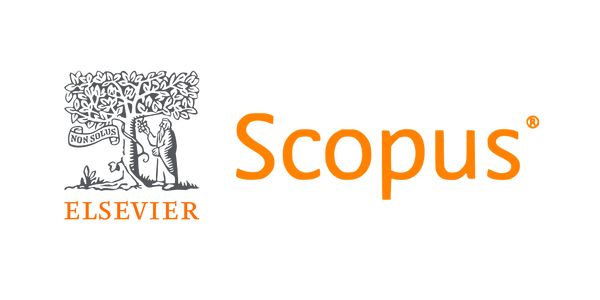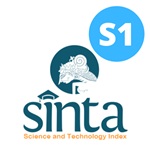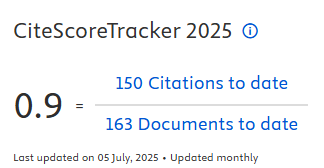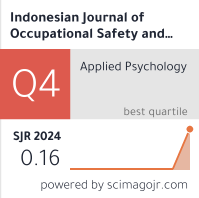Association Between Personal Hygiene Practices and Peripheral Blood Profiles in Agrarian Workers: An Analysis with Socio-demographic and Helminthiasis Considerations

Downloads
Introduction: Helminthiasis remains a significant public health issue in Indonesia, negatively impacting nutrition and cognitive development, particularly among individuals who are in direct contact with soil. To mitigate this issue, improving personal hygiene and awareness of infection prevention is essential. This study aims to examine the correlation between sociodemographic factors and personal hygiene with blood profiles among workers in agrarian areas. Methods: A cross-sectional approach was used, with 144 samples collected through purposive sampling in the agrarian area of Malang Regency. Data were gathered using questionnaires covering sociodemographic factors and personal hygiene, as well as through hematology tests results obtained from blood samples taken from respondents, which were tested at the dr. Saiful Anwar Malang General Hospital. For data analysis, the Chi-square test was utilized for bivariate analysis, while logistic regression was employed for multivariate analysis. Results: The mean age of respondents was 48.1 ± 14.1 years, with a majority having attained only an elementary education (51.4%) and primarily working as farmers (66.7%). Approximately 38.2% of respondents demonstrated poor personal hygiene. Significant associations were found between personal hygiene and hemoglobin levels (p=0.031), as well as eosinophil counts (p=0.007). Multivariate analysis showed that respondents who did not wash their hands before eating had 1.8 times higher odds of having abnormal blood profiles compared to those who practiced handwashing. Conclusion: The results of this study suggest that sociodemographic factors and personal hygiene are associated with the quality of blood profile among respondents. Enhanced education is needed to raise community awareness regarding personal hygiene.
Aemiro, A., et al. (2022) Prevalence of Soil-Transmitted Helminthes and Associated Risk Factors Among People of Ethiopia: A Systematic Review and Meta-Analysis, Infectious Diseases: Research and Treatment, 15, 117863372110554. https://doi.org/10.1177/11786337211055437
Amalia, S., et al. (2023) The Association of Clean and Healthy Living Behavior along with Hemoglobin and Serum Ferritin Levels among Adolescent Girls, Amerta Nutrition, 7(1), pp. 54–62. https://doi.org/10.20473/amnt.v7i1.2023.54-62
Apsari, B. P. I, et al. (2020) Gambaran Infeksi Soil Transmitted Helminth Pada Petani Di Desa Gelgel Kabupaten Klungkung, WICAKSANA: Jurnal Lingkungan Dan Pembangunan, 4(2), pp. 21–30. https://doi.org/10.22225/wicaksana.4.2.2676.21-30
Aryadnyani, N. P., Inderiati, D., and Ulfah, F. (2020) Hemoglobin Levels on Trichuris trichiura Infection in Children, Medical Laboratory Technology Journal, 1(1), pp. 78–83. https://doi.org/10.31964/mltj.v1i1.289
Asif Syed, M., et al. (2021) Pesticides and Chemicals as Potential Risk Factors of Aplastic Anemia: A Case–control Study among a Pakistani Population, Clinical Epidemiology, 13, pp. 469–475. https://doi.org/10.2147/CLEP.S304132
Baranwal, A., Baranwal, A., and Roy, N. (2014) Association of Household Environment and Prevalence of Anemia among Children under-5 in India, Frontiers in Public Health, 2(OCT), pp. 1–7. https://doi.org/10.3389/fpubh.2014.00196
Bouchery, T., et al. (2020). Hookworms Evade Host Immunity by Secreting a Deoxyribonuclease to Degrade Neutrophil Extracellular Traps, Cell Host and Microbe, 27(2), pp. 277-289.e6. https://doi.org/10.1016/j.chom.2020.01.011
Caldrer, S., et al. (2022) Soil-Transmitted Helminths and Anaemia: A Neglected Association Outside the Tropics, Microorganisms, 10(5), pp. 1-12. https://doi.org/10.3390/microorganisms10051027
Chaparro, C. M., and Suchdev, P. S. (2019) Anemia Epidemiology, Pathophysiology, and Etiology in Low- and Middle-income Countries, Annals of the New York Academy of Sciences, 1450(1), pp. 15–31. https://doi.org/10.1111/nyas.14092
Ejemot-Nwadiaro, R. I., et al. (2021). Hand-washing Promotion for Preventing Diarrhoea, Cochrane Database of Systematic Reviews, 2021(1), pp. 1-104. https://doi.org/10.1002/14651858.CD004265.pub4
Eren, T. K., and Aktekin, C. N. (2023) How Reliable are the Synovial Cell Count and Blood Parameters in the Diagnosis of Septic Arthritis?, Joint Diseases and Related Surgery, 34(3), pp. 724–730. https://doi.org/10.52312/jdrs.2023.1222
Farodis, I., and Purnadianti, M. (2020) Correlation Between Personal Hygiene And Hemoglobin Levels On Typhoid Fever Suspect Patients At Lirboyo General Hospital, Medicra (Journal of Medical Laboratory Science/Technology), 3(2), pp. 30–35. https://doi.org/10.21070/medicra.v3i2.800
Fattah, N., et al. (2020). Hubungan Personal Hygiene dan Sanitasi Lingkungan dengan Kejadian Penyakit Kecacingan, UMI Medical Journal, 5(2), pp. 47–55. https://doi.org/10.33096/umj.v5i2.78
Sabban, I. F., et al. (2023) Hasil Pemeriksaan Telur Soil Transmitted Helminths Pada Kuku Petani Di Desa Wonoayu Kabupaten Madiun, Jurnal Sintesis: Penelitian Sains, Terapan dan Analisisnya, 4(1), pp. 68-73.
Giacomin, P. R., et al. (2008) The Role of Complement in Innate, Adaptive and Eosinophil-Dependent Immunity to the Nematode Nippostrongylus Brasiliensis, Molecular Immunology, 45(2), pp. 446–455. https://doi.org/10.1016/j.molimm.2007.05.029
Idris, O. A., Wintola, O. A., and Afolayan, A. J. (2019) Helminthiases; Prevalence, Transmission, Host-parasite Interactions, Resistance to Common Synthetic Drugs and Treatment, Heliyon, 5(1), e01161. https://doi.org/10.1016/j.heliyon.2019.e01161
Irawan, N. A., et al. (2024) Gambaran Sanitasi Lingkungan dan Status Gizi dengan Infeksi Kecacingan pada Siswa Madrasah Ibtidaiyah Singosari, Boyolali, Plexus Medical Journal, 3(1), pp. 16–26. https://doi.org/10.20961/plexus.v3i1.1085
Kothari, M. T., et al. (2019) Exploring Associations between Water, Sanitation, and Anemia through 47 Nationally Representative Demographic and Health Surveys, Annals of the New York Academy of Sciences, 1450(1), pp. 249–267. https://doi.org/10.1111/nyas.14109
Lalangpuling, I. E., Manengal, P. O., and Konoralma, K. (2020) Personal Hygine dan Infeksi Cacing Enterobius Vermicularis Pada Anak Usia Pra Sekolah, Jurnal Kesehatan Lingkungan, 10(1), pp. 29–32. https://doi.org/10.47718/jkl.v10i1.891
Lestari, Y., G, F. N., and Saktiansyah, L. O. A. (2017) Analisis-Dampak-Kepadatan-Lalat-Sanitasi, Jurnal Ilmiah Mahasiswa Kesehatan Masyarakat, 2(6), pp. 1–9.
Ley, K., et al. (2018). Neutrophils: New Insights and Open Questions, Science Immunology, 3(30). https://doi.org/10.1126/sciimmunol.aat4579
Listiana A. (2016) Analisis Faktor-faktor yang Berhubungan dengan Kejadian Anemia Gizi Besi pada Remaja Putri di SMKN 1 Terbanggi Besar Lampung Tengah, Jurnal Kesehatan, VII(3), pp. 455–469.
Lopes, S. O., et al. (2022) Factors Associated with Anemia among Adults and the Elderly Family Farmers, International Journal of Environmental Research and Public Health, 19(12), pp. 1-10. https://doi.org/10.3390/ijerph19127371
Loukas, A., et al. (2016) Hookworm Infection, Nature Reviews Disease Primers, 2(1), pp. 1-8. https://doi.org/10.1038/nrdp.2016.88
Mahyuni, E. L., et al. (2021) Pesticide Toxicity Prevention in Farmer’s Community Movement, Open Access Macedonian Journal of Medical Sciences, 9(E), pp. 1–7. https://doi.org/10.3889/oamjms.2021.5565
Mationg, M. L. S., et al. (2022)“The Magic Glasses Philippines”: A Cluster Randomised Controlled Trial of a Health Education Package for the Prevention of Intestinal Worm Infections in Schoolchildren, The Lancet Regional Health - Western Pacific, 18, pp. 1-16. https://doi.org/10.1016/j.lanwpc.2021.100312
Murni, P. H. S., Lubis, M., and Fujiati, I. I. (2018 Hubungan Infeksi Soil Transmitted Helminths dengan Kemampuan Kognitif, Status Nutrisi, dan Prestasi Belajar pada Anak Sekolah Dasar di Desa Sikapas Kabupaten Mandailing Natal, Sari Pediatri, 19(5), pp. 279-283. https://doi.org/10.14238/sp19.5.2018.279-83
Mutalazimah, M., and Putri, D. P. (2021) Helminthiasis, Iron Intake, and Hemoglobin Levels in Pregnant Women, Enfermeria Clinica, 31, pp. S252–S256. https://doi.org/10.1016/j.enfcli.2020.09.011
Nath, T. C., et al. (2022) An Update of Intestinal Helminth Infections among Urban Slum Communities in Bangladesh, IJID Regions, 5(July), pp. 1–7. https://doi.org/10.1016/j.ijregi.2022.08.004
Ntonifor, H. N., et al. (2021) Intestinal Helminths as Predictors of Some Malaria Clinical Outcomes and il-1β Levels in Outpatients Attending Two Public Hospitals in Bamenda, North West Cameroon, PLoS Neglected Tropical Diseases, 15(3), pp. 1–17. https://doi.org/10.1371/journal.pntd.0009174
Nurudeen, A. S. N., and Toyin, A. (2020) Knowledge of Personal Hygiene among Undergraduates, Journal of Health Education, 5(2), pp. 66–71. https://doi.org/10.15294/jhe.v5i2.38383
Prabandari, A. S., Sari, A. N., and Ahtamagara, A. F. (2023) Infeksi Nematoda Usus pada Petani di Kabupaten Sukoharjo Jawa Tengah dan Faktor yang Mempengaruhinya, Indonesian Journal on Medical Science, 10(2), pp. 164-171. https://doi.org/10.55181/ijms.v10i2.432
Prentice, A. M., et al. (2019) Respiratory Infections Drive Hepcidin-mediated Blockade of Iron Absorption Leading to Iron Deficiency Anemia in African Children, Science Advances, 5(3), 1–8. https://doi.org/10.1126/sciadv.aav9020
Primadana, A., et al. (2019). Eosinophilia Sebagai Prediktor Morbiditas Soil- Transmitted Helminthiases Pada Pekerja Perkebunan Widodaren, Jember, Journal of Vocational Health Studies, 3, pp. 47–52. https://doi.org/10.20473/jvhs.V3I2.2019.47
Radi, R., Rejeki, D. S. S. and Octaviana, D. (2024). A Literature Review: Factors Influencing the Incidence of Anemia in Farmers in the World, Jambi Medical Journal,12(1), pp. 53–59. https://doi.org/10.22437/jmj.v12i1.30876
Ramirez, G. A., et al. (2018) Eosinophils from Physiology to Disease: A Comprehensive Review. BioMed Research International, 2018, pp. 1-28. https://doi.org/10.1155/2018/9095275
Statistic of Malang Regency (2021) Kecamatan Poncokusumo dalam angka 2022. Malang: CV Kurnia.
Sulistyawati, S., et al. (2019). Riwayat Paparan Pestisida dan Kekurangan Asupan Zat Gizi Sebagai Faktor Risiko Kejadian Anemia pada Ibu Hamil di Daerah Pertanian, Jurnal Gizi Indonesia (The Indonesian Journal of Nutrition), 7(2), pp. 69–75. https://doi.org/10.14710/jgi.7.2.69-75
Suraya, C., et al. (2020). CITRA DELIMA : Jurnal Ilmiah STIKES Citra Delima Bangka Belitung Hubungan Hygiene Makanan, Sumber Air dan Personal Hygiene dengan Kejadian Diare pada Anak. Ji, 3(2), 94–100. http://jurnalilmiah.stikescitradelima.ac.id/index.php/
Taj, M., et al. (2016) Environmental Determinants of Aplastic Anemia in Pakistan: A Case-control Study, Journal of Public Health (Germany), 24(5), pp. 453–460. https://doi.org/10.1007/s10389-016-0743-6
Teshale, A. B., et al. (2020) Anemia and Its Associated Factors among Women of Reproductive Age in Eastern Africa: A Multilevel Mixed-effects Generalized Linear Model, PLoS ONE, 15(9), pp. 1–16. https://doi.org/10.1371/journal.pone.0238957
Tofel, H. K., et al. (2024) Intestinal Helminthiasis, Anaemia and Associated Risk Factors in A Cross-Section of the Population of Melong, Littorial Region of Cameroo, Scientific Reports, 14(1), pp. 1–13. https://doi.org/10.1038/s41598-023-46446-9
World Health Organization (2023). Soil-Transmitted Helminth Infections. Geneva: World Health Organization
Yushananta, P., et al. (2021) Anemia and its Associated Factors Among Women of Reproductive Age in Horticulture Area, Jurnal Aisyah : Jurnal Ilmu Kesehatan, 6(2), pp. 317–325. https://doi.org/10.30604/jika.v6i2.498

This work is licensed under a Creative Commons Attribution-NonCommercial-ShareAlike 4.0 International License.

In order to be accepted and published by The Indonesian Journal of Occupational Safety and Health, Author(s) who submit an article should complete all the review process. The copyright of received articles assigned to the The Indonesian Journal of Occupational Safety and Health and Department of Safety and Health, Universitas Airlangga as publishers of the journal. The intended copyright includes the rights to publish articles in various forms (including reprints).
The Editorial Team of The Indonesian Journal Of Occupational Safety and Health and Department of Safety and Health strive to ensure that no errors occur in the articles that have been published, both data errors and statements in the article.
Users of this website will be licensed to use materials from this website following the Creative Commons Attribution-NonCommercial-ShareAlike 4.0 International License. No fees charged. Please use the materials accordingly.
------------------------------------------------------------------------------------------------------------------------------------------------------------------------------------------
Attribution ” You must give appropriate credit, provide a link to the license, and indicate if changes were made. You may do so in any reasonable manner, but not in any way that suggests the licensor endorses you or your use.
NonCommercial ” You may not use the material for commercial purposes.
ShareAlike ” If you remix, transform, or build upon the material, you must distribute your contributions under the same license as the original.







 How to Submit Articles in OJS
How to Submit Articles in OJS

























